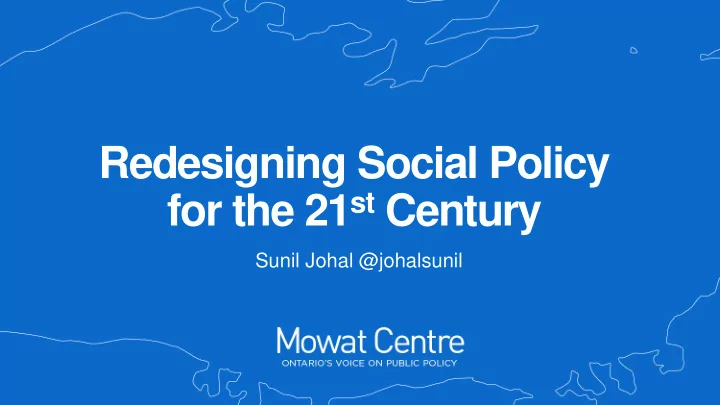

Redesigning Social Policy for the 21 st Century Sunil Johal @johalsunil
Key Trends 1
Unequal Prosperity Income inequality continues to grow by all measures Canada’s top 1% of earners accounted for 37% of the country’s overall income growth between 1981 and 2010 2
Unequal Prosperity The “Great Decoupling” implies that while the economy continues to grow, wages have remained mostly stagnant for almost 30 years 3
Rise of precarious work The standard employment relationship - characterized by full- time hours, permanency and benefits - is becoming increasingly rare 4
Understanding the new economy: Emerging Issues • Unique nature of the digital economy • Increasingly firms are characterized by powerful network effects, low barriers to entry and fewer full- time employees • Living in an on-demand society • New business models often blur boundaries of who is considered an employee (e.g. increase use of independent contractor classification) 5
Understanding the new economy: Emerging Issues • Automation of industry • Advancements in automation and AI are now replacing human muscle power as well brain power • Deconstructing a job and outsourcing constituent tasks can be understood as part of progression towards automation 6
Automation of industry 7
Automation of industry Many studies have attempted to estimate the size of job loss due to automation across various jurisdictions, using different methodologies 8
Automation of industry Deconstructing a job and outsourcing its constituent tasks can be understood as part of a progression towards automation in which jobs become less stable and less well-paid 9
What’s the impact? • Increased uncertainty • Pace of change • Constant disruption and volatility • Significant pressure on existing regulatory/social and economic frameworks • Increased need for quick, coordinated and international responses 10
Public Policy Implications 11
Six key policy areas will face pressures to modernize 12
How is our social architecture holding up? • 39% of unemployed Canadians currently receive regular EI benefits, compared to 82% in 1978 • 48% of working-aged Canadians have not started or are currently not saving for their retirement • Over 80% of precarious workers in Ontario do not receive benefits such as vision, dental, drug, life insurance 13
How is our social architecture holding up? • Only enough centre-based spaces to care for 22.5% of children under 5 years old • Stagnant incomes at bottom of the income distribution scale have been outpaced by private market rental prices • A growing number of Canadians may not be entitled to various employment standards protections 14
Programs of the future will be… • Delivered digitally to increase efficiency and reduce transactional costs for citizens and governments • Clearly focused on outcomes that require policy action (e.g., increasing availability of timely, impactful skills training to unemployed workers) • Evaluated for effectiveness and impact, and continually refreshed to adjust to emerging social and economic conditions • Customized and flexibly designed to accommodate the varied needs of citizens • Integrated with other service and programs offered by government and delivery partners 15
Two examples • Singapore’s SkillsFuture & France’s Personal Activity Accounts. • Both programs are designed to provide citizens with easier access to services that they need, when they need them. • Singapore: digital platform to access learning resources, integrated training supports and an individualized credit of $500 that is periodically topped up • The French model provides customized training supports and credits for people facing different life situations 16
Transformational changes • Danish “ flexicurity ” model • Portable benefits • Work- sharing schemes (e.g. Germany’s Kurzarbeit) • Guaranteed annual income • National skills strategy 17
@johalsunil sunil@mowatcentre.ca Stay Connected 18
Recommend
More recommend